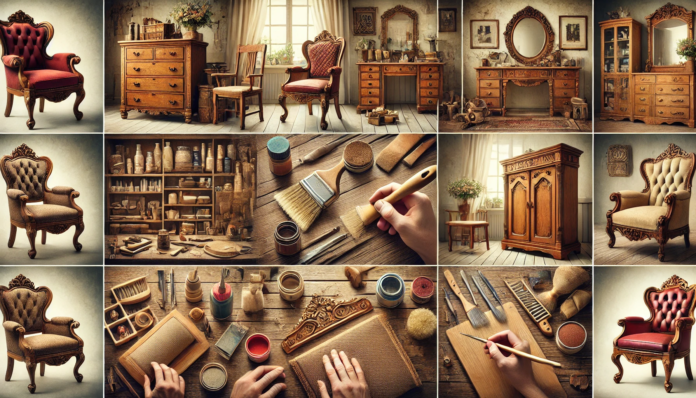Restoring antique furniture is an art that requires a delicate balance between preserving the piece’s original character and making necessary repairs. Whether you’re restoring a family heirloom or a vintage market find, proper techniques and materials are crucial to maintaining the integrity and value of the furniture. This guide provides an overview of the steps involved in antique furniture restoration and tips for preserving these valuable pieces.
1. Assessment and Planning
Evaluate the Condition
Before starting the restoration process, thoroughly assess the condition of the furniture. Identify areas that need repair, such as loose joints, damaged finishes, or missing hardware. Determine whether the piece has historical or sentimental value, which can influence restoration decisions.
Research the Piece
Research the history and style of the furniture to understand its original construction and materials. This knowledge can guide you in choosing appropriate restoration methods and materials that match the original.
2. Cleaning and Surface Preparation
Gentle Cleaning
Begin by gently cleaning the furniture to remove dirt, grime, and old wax. Use a mild detergent mixed with water and a soft cloth. Avoid harsh chemicals that can damage the finish or wood. For intricate details, use a soft brush.
Removing Old Finish
If the original finish is severely damaged, you may need to remove it. Use a suitable paint stripper or sandpaper to strip away the old finish. Work carefully to avoid damaging the wood underneath. For veneered surfaces, be extra cautious to prevent sanding through the veneer.
3. Repair and Restoration
Fixing Structural Issues
Address structural issues such as loose joints, broken parts, or missing pieces. Use wood glue and clamps to reattach loose joints. Replace missing parts with similar wood, shaping and fitting them carefully. For significant structural damage, consider consulting a professional restorer.
Filling Cracks and Holes
Fill cracks and holes with wood filler that matches the wood’s color. Sand the area smoothly once the filler is dry, blending it with the surrounding wood.
Refinishing
After repairs, apply a new finish to protect the wood and enhance its appearance. Choose a finish that complements the original, such as shellac, lacquer, or varnish. Apply the finish in thin, even coats, allowing each coat to dry thoroughly before applying the next.
4. Reupholstery
Removing Old Upholstery
If the piece includes upholstered elements, carefully remove the old fabric and padding. Take note of the original upholstery techniques and materials used, as these can provide valuable insights for reupholstering.
Selecting New Fabric
Choose a fabric that is appropriate for the period and style of the piece. Consider durability and colorfastness, especially if the furniture will be used regularly. Reupholster the piece using traditional methods, such as hand-stitching or tacking, to maintain authenticity.
5. Preservation and Maintenance
Proper Care
Once restored, proper care and maintenance are essential to preserving antique furniture. Avoid placing the furniture in direct sunlight or near heat sources, as these can cause fading and warping. Dust regularly with a soft cloth and use a furniture wax or polish recommended for antiques.
Regular Inspection
Periodically inspect the furniture for signs of wear or damage. Address any issues promptly to prevent further deterioration. For valuable or historically significant pieces, consider consulting a professional conservator for ongoing maintenance and care.
Conclusion
Antique furniture restoration is a rewarding process that combines craftsmanship, historical knowledge, and an appreciation for the piece’s original beauty. By following proper restoration techniques and using appropriate materials, you can bring new life to cherished antiques while preserving their historical value. Whether you’re a seasoned restorer or a novice, patience and attention to detail are key to successful restoration. With care and maintenance, restored antique furniture can be enjoyed for generations to come.
Frequently Asked Questions
What should I consider before starting antique furniture restoration?
Before starting restoration, assess the furniture’s condition, historical value, and the extent of the repairs needed. Research the piece’s history and original construction to guide your restoration approach. Decide whether you want to restore the piece to its original state or make modifications for modern use.
Can I restore antique furniture myself, or should I hire a professional?
While minor repairs and cleaning can often be done by enthusiasts, more extensive restoration work may require professional expertise, especially for valuable or historically significant pieces. If you’re unsure about the process or the materials to use, consulting a professional restorer is advisable.
How do I choose the right finish for antique furniture?
Choosing the right finish depends on the original finish and the desired look. Traditional finishes like shellac, lacquer, and varnish are commonly used for antique furniture. Research the period and style of the piece to determine the appropriate finish, and consider the furniture’s future use and exposure to elements.
How can I preserve the value of restored antique furniture?
To preserve the value of restored antique furniture, avoid making irreversible changes or using modern materials that are inconsistent with the original. Maintain the piece with proper care, such as avoiding direct sunlight and using appropriate cleaning products. Document any restoration work done, as this can provide valuable information for future owners or restorers.
What are common mistakes to avoid during antique furniture restoration?
Common mistakes include over-sanding, which can remove valuable patina, using inappropriate finishes or materials, and making structural changes that alter the piece’s original design. It’s important to work slowly and carefully, preserving as much of the original material and craftsmanship as possible.
How often should antique furniture be maintained?
Regular maintenance, such as dusting and occasional waxing, can help preserve antique furniture. Inspect the piece periodically for signs of wear or damage, and address any issues promptly. The frequency of maintenance depends on the furniture’s use and exposure to environmental factors like sunlight and humidity.

